Beth Kephart's Blog, page 69
October 8, 2014
on history sanitized and simplified for younger readers: let's think about this
 In today's New York Times, Alexander Alter writes of the increasing number of "adult" authors who are reconfiguring their history books for the younger, still-book-buying crowd (or for those who buy books for them). She writes:
In today's New York Times, Alexander Alter writes of the increasing number of "adult" authors who are reconfiguring their history books for the younger, still-book-buying crowd (or for those who buy books for them). She writes:Inspired by the booming market for young adult novels, a growing number of biographers and historians are retrofitting their works to make them palatable for younger readers. Prominent nonfiction writers like Ms. Hillenbrand, Jon Meacham and Rick Atkinson are now grappling with how to handle unsettling or controversial material in their books as they try to win over this impressionable new audience.I wonder about the wisdom of this—about the felt need to take well-written and absorbing histories and make them less than (for sanitized and simplified sound like less than to me) for younger readers. Let's first acknowledge what many young readers are capable of, which is to say, books rich with moral dilemma and emboldened by ideas. Let's next acknowledge what young readers need, which is to say the facts of then and now.
And these slimmed-down, simplified and sometimes sanitized editions of popular nonfiction titles are fast becoming a vibrant, growing and lucrative niche.
You can already get that sort of thing in novels written for younger readers. Certainly Patricia McCormick is not writing down, making it easy, simplifying when she writes about the sex trade or the Cambodian war. Certainly Ruta Sepetys didn't make Siberia comfortable in Between Shades of Gray. Certainly M. T. Anderson didn't set out to make Octavian Nothing easy, simple, sterile. Certainly, Marilyn Nelson, publishing Carver, a life in verse for young adults, didn't think to herself, let me make this easy. She wrote each page smart, each page full of innuendo and terms to look up and mysteries, like this:
And certainly I, writing novels for young adults, am not setting history down in burnished, skip-over-it slices. Not when I write about the Spanish Civil War (Small Damages) or the shadowy blockade of the Berlin Wall (Going Over) or Centennial Philadelphia (Dangerous Neighbors) or 1871 Philadelphia (Dr. Radway's Sarsaparilla Resolvent) or Florence during the 1966 flood (One Thing Stolen). I am working to put a younger reader into the heart of it all. And sometimes that's not pretty. Sometimes that hurts. But that is history for you.
A Charmed Life
Here breathes a solitary pilgrim sustained by dewand the kindness of strangers. An astonished Midassurrounded by the exponentially multiplying miracles: myYucca and Cactus in the Chicago World Exposition;friends of the spirit; teachers. Ah, the bleak horizons of joy.Light every morning dawns through the trees. Surelythis is worth more than one life.
That's life.
YA writers have been writing sophisticated historical novels for a long time now. Why, then, suggest that those same YA readers need to be written down to when it comes to pure nonfiction? To the big stories. The telling moments. The individual against the state, the home versus the political, the science versus the dream, the big stuff that shapes who we became. Nonfiction for young adults, like novels for young adults, should be alive and deep and somehow true. It should respect the capabilities of younger readers.




Published on October 08, 2014 05:14
October 6, 2014
One Thing Stolen ARCs arrive; Going Over is kindly reviewed
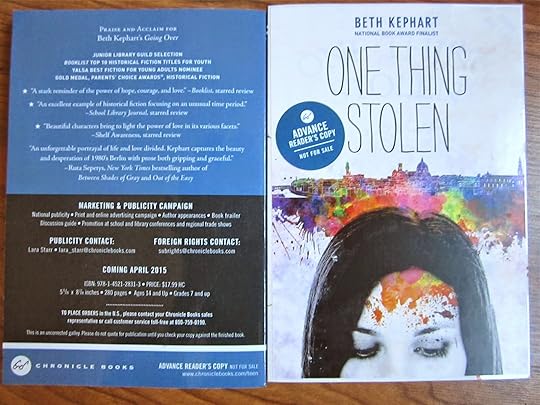 and in some ways, one photograph captures it all. With huge thanks to the Chronicle team, to my friend Ruta Sepetys (whose Going Over quote is here, on the back of One Thing Stolen), and to Patricia Hruby Powell, who so beautifully reviewed Going Over for The News-Gazette; her review can be found here.
and in some ways, one photograph captures it all. With huge thanks to the Chronicle team, to my friend Ruta Sepetys (whose Going Over quote is here, on the back of One Thing Stolen), and to Patricia Hruby Powell, who so beautifully reviewed Going Over for The News-Gazette; her review can be found here.



Published on October 06, 2014 13:55
not a liar, not accurate either (Eula Biss)
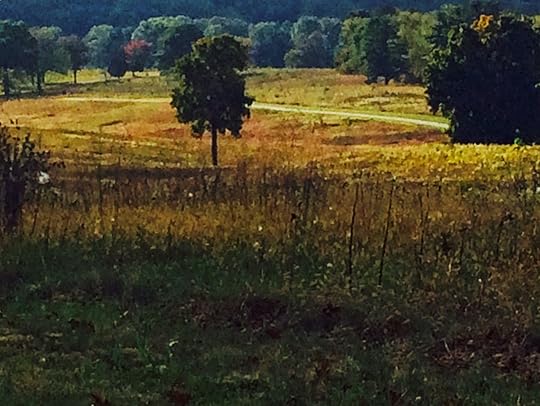
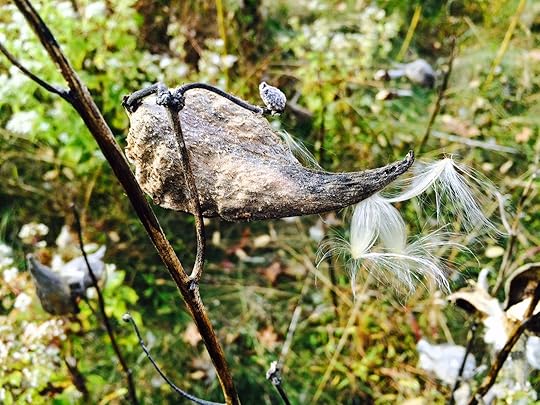
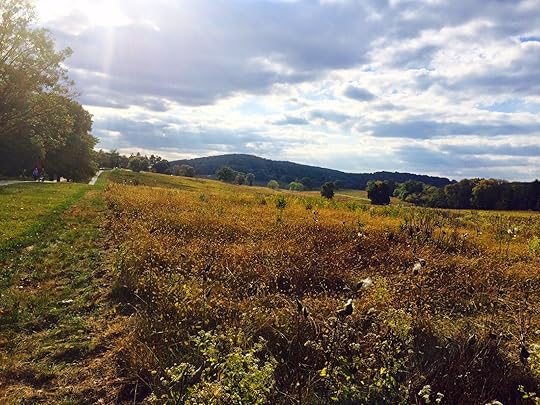 As Eula Biss makes headlines with her new examination of vaccines and social inoculation, On Immunity, I have been reading her first book, an exquisite inversion of the memoir form. Released in 2002 by Hanging Loose Press, The Balloonists is a patchwork of impressions and inquiries about marriage. The kind of marriage the author's parents had. The kind the author contemplates on her own. In between, declarations of impossibility.
As Eula Biss makes headlines with her new examination of vaccines and social inoculation, On Immunity, I have been reading her first book, an exquisite inversion of the memoir form. Released in 2002 by Hanging Loose Press, The Balloonists is a patchwork of impressions and inquiries about marriage. The kind of marriage the author's parents had. The kind the author contemplates on her own. In between, declarations of impossibility.For example:
"At some point," my mother tells me, "you realize that your parents are not who you thought they were. You realize that they are something separate from what you have made out of them." She tells me this because she knows that I have been writing about her. It is what she says instead of saying, "You don't know me."I took these photos yesterday while walking Valley Forge National Historical Park with my friend, the amazing writer ( Badlands ) and teacher, Cyndi Reeves. Over four point five miles (Cyndi tells me), the conversation ranged from Krakow to Siena to the architectural form of stories to the autobiographical possibilities of fairy tales, and, in the final uphill climb, to Eula Bliss, whose The Balloonists Cyndi had also read years before I discovered it.
"For example," she says, "my sister always felt that our father didn't like her. Of course he liked her, he just didn't understand how to show that he liked her. She didn't really have a father that didn't like her, but that doesn't change the fact that she had the experience of having a father who didn't like her." My mother is telling me that I am not a liar, but that she is not what I write about her.
I was out of breath on the hill. I was grateful beyond measure to have a friend like Cyndi to talk The Balloonists with.




Published on October 06, 2014 04:57
not a liar, not accurate either (Eula Bliss)


 As Eula Bliss makes headlines with her new examination of vaccines and social inoculation, On Immunity, I have been reading her first book, an exquisite inversion of the memoir form. Released in 2002 by Hanging Loose Press, The Balloonists is a patchwork of impressions and inquiries about marriage. The kind of marriage the author's parents had. The kind the author contemplates on her own. In between, declarations of impossibility.
As Eula Bliss makes headlines with her new examination of vaccines and social inoculation, On Immunity, I have been reading her first book, an exquisite inversion of the memoir form. Released in 2002 by Hanging Loose Press, The Balloonists is a patchwork of impressions and inquiries about marriage. The kind of marriage the author's parents had. The kind the author contemplates on her own. In between, declarations of impossibility.For example:
"At some point," my mother tells me, "you realize that your parents are not who you thought they were. You realize that they are something separate from what you have made out of them." She tells me this because she knows that I have been writing about her. It is what she says instead of saying, "You don't know me."I took these photos yesterday while walking Valley Forge National Historical Park with my friend, the amazing writer ( Badlands ) and teacher, Cyndi Reeves. Over four point five miles (Cyndi tells me), the conversation ranged from Krakow to Siena to the architectural form of stories to the autobiographical possibilities of fairy tales, and, in the final uphill climb, to Eula Bliss, whose The Balloonists Cyndi had also read years before I discovered it.
"For example," she says, "my sister always felt that our father didn't like her. Of course he liked her, he just didn't understand how to show that he liked her. She didn't really have a father that didn't like her, but that doesn't change the fact that she had the experience of having a father who didn't like her." My mother is telling me that I am not a liar, but that she is not what I write about her.
I was out of breath on the hill. I was grateful beyond measure to have a friend like Cyndi to talk The Balloonists with.




Published on October 06, 2014 04:57
October 5, 2014
at work on something new, sixty pages in, I
 feel my body ease, my mind knock back the anxiety that is too much of who I naturally am. We writers can't know if our work will be of interest to one other soul. We can know if it is of interest to us. If it wakes us up in the morning, teasing: Choose me. Come near. See what happens next.
feel my body ease, my mind knock back the anxiety that is too much of who I naturally am. We writers can't know if our work will be of interest to one other soul. We can know if it is of interest to us. If it wakes us up in the morning, teasing: Choose me. Come near. See what happens next.I'm a mere sixty pages into a novel for adults.
I want to see what happens next.
I realize just how much this new, strange, possibly impossible project means to me when friends ask (in our living room Friday, over an amazing dinner, last night) what I'm working on, and I feel suddenly electric in the telling.
(And glad for their forgiveness, if suddenly I talk too much.)
Added later in the day: Miss Kelly very intelligently asks why I, never a fan of labels, stuck a label into this post. Here are the facts: This new book is only partly true and so it is definitely more fiction than nonfiction. Its protagonist begins as a teen but grows into a woman, and so the book would never be bought by a publishing house focused on young adult books. I was thinking more about how this book might ultimately be published than by whom it might ultimately be read when I used the term "novel for adults." But darn, it's true, I don't like labels, and since I don't, I should probably not use them.




Published on October 05, 2014 04:38
October 4, 2014
Fear less, love more: wise words from Marilynne Robinson, in conversation with Wyatt Mason
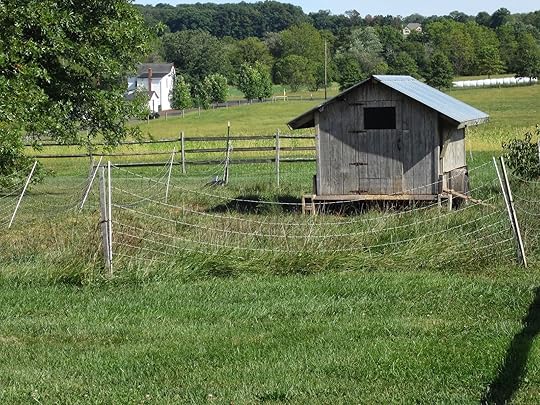 Our greatest writers do not merely assuage, entertain, delight, and challenge us. They teach us something about humanity, something about how art gets done.
Our greatest writers do not merely assuage, entertain, delight, and challenge us. They teach us something about humanity, something about how art gets done.Marilynne Robinson is one of our greatest writers, and while I have not yet read her new novel, Lila (I will), I have been taking great pleasure from the reviews and conversations surrounding its release.
Take the magnificent conversation Robinson has with New York Times Magazine writer Wyatt Mason, which can be found here. The profile goes far beyond the bounds of the writer's work and ways. It dives straight into the heart of us. Here, for example, the two are musing over fear—the control it has over our lives:
“I hate to say it, but I think a default posture of human beings is fear.” Perched on the edge of a sofa, hands loosely clasped, Robinson leaned forward as if breaking bad news to a gentle heart. “What it comes down to — and I think this has become prominent in our culture recently — is that fear is an excuse: ‘I would like to have done something, but of course I couldn’t.’ Fear is so opportunistic that people can call on it under the slightest provocations: ‘He looked at me funny.’ ”Later, Mason returns to the topic:
“ ‘So I shot him,’ ” I said.
“Exactly.”
“ ‘Can you blame me?’ ”
‘‘Exactly. Fear has, in this moment, a respectability I’ve never seen in my life.”
And it was here that Robinson brought up fear: How it has come to keep us at bay from our best selves, the selves that could and should “do something.” In her case, that “something” has been writing. For Robinson, writing is not a craft; it is “testimony,” a bearing witness: an act that demands much of its maker, not least of which is the courage to reveal what one loves.Fear less. Love more. An urging I needed desperately this weekend.




Published on October 04, 2014 07:01
October 3, 2014
Some Luck by Jane Smiley (in Chicago Tribune)
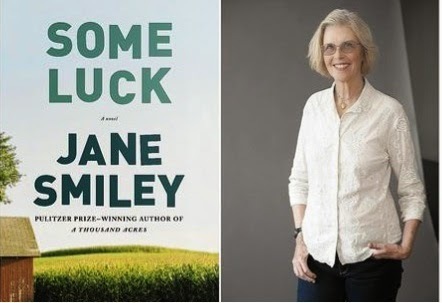 I was privileged to review this National Book Award long list selection for Printers Row Journal. The piece begins like this, below, and continues here.
I was privileged to review this National Book Award long list selection for Printers Row Journal. The piece begins like this, below, and continues here.
Life is one thing and then another, one day and soon the next, ambition superseded by surprise, desire thwarted by the reality we didn't forecast. Sometimes we get out in front of life. Oftentimes, we don't.
So here's the question: Where, in all of this, is the plot? The conflict and the climax? The sure cause and the clear effect? The resounding resolution? Life is successive and iterative; it is not inherently themed or arced.
Open linkHow audaciously delicious, then, that Jane Smiley has turned her considerable talents to a trilogy called "The Last Hundred Years" — and that she means it. One hundred years, one hundred chapters, the first 34 of which can be found in Book 1, titled "Some Luck." It's the Langdon family saga, the story of an Iowa farm and the people who inhabit it, the fences that stitch, the horizons that beckon, the love that lives in plain sight and inside a child's biscuits.
"Some Luck," simply and impossibly enough, is the story of what happens next.




Published on October 03, 2014 02:43
October 2, 2014
a study in odd similarities

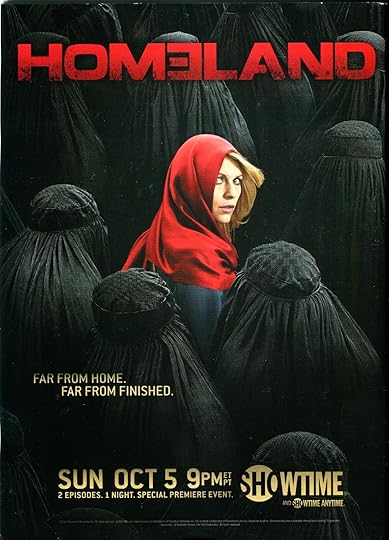
To the left, the illustration my husband created to support a keynote on the future of young adult literature I gave at a Publishing Perspectives conference two years ago. To the right, the back cover of this week's New Yorker.
Hmmmm, I say.




Published on October 02, 2014 10:14
October 1, 2014
Inviting you to two Schuylkill River talks, on behalf of the River of the Year honor
 <!-- /* Style Definitions */ p.MsoNormal, li.MsoNormal, div.MsoNormal {mso-style-parent:""; margin:0in; margin-bottom:.0001pt; mso-pagination:widow-orphan; font-size:12.0pt; font-family:"Times New Roman"; mso-fareast-font-family:"Times New Roman"; mso-bidi-font-family:"Times New Roman";} h1 {mso-style-link:"Heading 1 Char"; mso-style-next:Normal; margin-top:0in; margin-right:0in; margin-bottom:0in; margin-left:3.0in; margin-bottom:.0001pt; text-indent:-3.0in; mso-pagination:widow-orphan; page-break-after:avoid; mso-outline-level:1; font-size:12.0pt; font-family:"Times New Roman"; mso-font-kerning:0pt; mso-bidi-font-weight:bold;} h2 {mso-style-link:"Heading 2 Char"; mso-style-next:Normal; margin:0in; margin-bottom:.0001pt; text-align:center; mso-pagination:widow-orphan; page-break-after:avoid; mso-outline-level:2; font-size:12.0pt; font-family:"Times New Roman"; font-weight:normal;} p.MsoTitle, li.MsoTitle, div.MsoTitle {mso-style-link:"Title Char"; margin:0in; margin-bottom:.0001pt; text-align:center; mso-pagination:widow-orphan; font-size:18.0pt; mso-bidi-font-size:12.0pt; font-family:"Times New Roman"; mso-fareast-font-family:"Times New Roman"; mso-bidi-font-family:"Times New Roman";} a:link, span.MsoHyperlink {mso-style-parent:""; color:blue; text-decoration:underline; text-underline:single;} a:visited, span.MsoHyperlinkFollowed {mso-style-noshow:yes; color:purple; text-decoration:underline; text-underline:single;} span.Heading1Char {mso-style-name:"Heading 1 Char"; mso-style-locked:yes; mso-style-link:"Heading 1"; mso-ansi-font-size:12.0pt; mso-bidi-font-size:12.0pt; font-weight:bold;} span.Heading2Char {mso-style-name:"Heading 2 Char"; mso-style-locked:yes; mso-style-link:"Heading 2"; mso-ansi-font-size:12.0pt; mso-bidi-font-size:12.0pt;} span.TitleChar {mso-style-name:"Title Char"; mso-style-locked:yes; mso-style-link:Title; mso-ansi-font-size:18.0pt; mso-bidi-font-size:12.0pt;} @page Section1 {size:8.5in 11.0in; margin:1.0in 1.25in 1.0in 1.25in; mso-header-margin:.5in; mso-footer-margin:.5in; mso-paper-source:0;} div.Section1 {page:Section1;} </style> --> <br /><div class="MsoTitle"><span style="font-size: 11.0pt;"><span style="color: #3d85c6;">(I will be giving this talk on Tuesday October 14 at Montgomery County Community College and on October 16 at Trinity Urban Life Center, Philadelphia, PA. Both talks are free and open to the public. We would love to see you.) </span></span></div><div class="MsoTitle"><br /></div><div class="MsoTitle"><span style="font-size: 11.0pt;">Schuylkill River Heritage Area</span></div><div align="center" class="MsoNormal" style="text-align: center;"><span style="font-size: 11.0pt;">140 College Drive</span></div><h2><span style="font-size: 11.0pt;">Pottstown, PA<span style="mso-spacerun: yes;"> </span>19464</span></h2><div align="center" class="MsoNormal" style="text-align: center;"><span style="font-size: 11.0pt;"><a href="http://www.schuylkillriver.org/"... Immediate Release</h1><div class="MsoNormal">September 29, 2014</div><div class="MsoNormal"><span style="mso-tab-count: 1;"> </span><span style="mso-spacerun: yes;"> </span><span style="mso-spacerun: yes;"> </span><b style="mso-bidi-font-weight: normal;">C</b><b style="mso-bidi-font-weight: normal;"><span style="font-size: 11.0pt; mso-bidi-font-size: 12.0pt;">ontact:</span></b></div><div class="MsoNormal" style="margin-left: 3.0in; text-indent: -3.0in;"><span style="font-size: 11.0pt; mso-bidi-font-size: 12.0pt;"><span style="mso-tab-count: 1;"> </span><span style="mso-tab-count: 1;"> </span></span><span style="font-size: 11.0pt;">Laura Catalano</span></div><div class="MsoNormal" style="margin-left: 3.0in; text-indent: -3.0in;"><span style="font-size: 11.0pt;"><span style="mso-spacerun: yes;"> </span><span style="mso-tab-count: 1;"> </span><span style="mso-tab-count: 1;"> </span>lcatalano@schuylkillriver.org<span style="mso-spacerun: yes;"> </span></span></div><div class="MsoNormal"><span style="font-size: 11.0pt;"><span style="mso-spacerun: yes;"> </span><span style="mso-tab-count: 1;"> </span>(484) 945-0200</span></div><div class="MsoNormal"><br /></div><h1 align="center" style="text-align: center;"><span style="font-size: 16.0pt;"><span style="mso-spacerun: yes;"> </span></span><span style="font-size: 14.0pt;">Author to Speak about Schuylkill River and the Imagination</span></h1><div class="MsoNormal"><br /></div><div class="MsoNormal"><b>POTTSTOWN</b>–“That’s the thing about this river: you have to imagine it to see it.” That line was written by award-winning author Beth Kephart in the prelude to her book <i style="mso-bidi-font-style: normal;">Flow: The Life and Times of Philadelphia’s Schuylkill River.</i></div><div class="MsoNormal"><br /></div><div class="MsoNormal">On Tuesday, October 14 Kephart will talk about the place the Schuylkill River has forged in her own imagination. Her talk will take place at Montgomery County Community College West Campus, in the Community Room in South Hall at 7 p.m. A second presentation will be held on Thursday Oct. 16 at 7 p.m. at the Trinity Center for Urban Life in Philadelphia.</div><div class="MsoNormal"><br /></div><div class="MsoNormal">Both talks are free, but attendees are asked to register at <a href="https://riverdreams.eventbrite.com/&q... or by calling the Schuylkill River Heritage Area at 484-945-0200.</div><div class="MsoNormal"><br /></div><div class="MsoNormal">In addition to speaking about the place the Schuylkill River has in her own imagination and teaching, she will also look at the impact rivers have on all our lives, and the legacy of those who have worked to restore Philadelphia’s essential waterways.</div><div class="MsoNormal"><br /></div><div class="MsoNormal">Kephart is a National Book Award finalist and an acclaimed author and educator. Her book, <i style="mso-bidi-font-style: normal;">Flow, </i>is an imaginative telling of the life of the Schuylkill River written in short, thought-provoking, impressionistic chapters. The book was published in 2007 by Temple University Press, and was reprinted in paperback earlier this year.</div><div class="MsoNormal"><br /></div><div class="MsoNormal">The Schuylkill was named Pennsylvania’s 2014 River of the Year. Kephart’s talk, entitled RIVER DREAMS: History, Hope and the Imagination, will serve as the keynote address for the Schuylkill River Heritage Area’s River of the Year Speaker Series. Kephart developed the presentation specifically for that purpose. </div><div class="MsoNormal"><br /></div><div class="MsoNormal"><span style="font-family: Calibri, Verdana, Helvetica, Arial;"><span style="font-size: 11pt;">“At a time of global uncertainty, the restoration of our rivers—and of our Schuylkill in particular—is a kind of poetry, proof of what remains possible," says Kephart. "I’m interested in the possible. I’m leavened by it.” </span></span> </div><div class="MsoNormal"><br /></div><div class="MsoNormal">“Our goal in hosting a River of the Year speaker series has been to introduce people to various aspects of the Schuylkill River,” said Schuylkill River Heritage Area Executive Director Kurt Zwikl. “We are pleased to be able to offer two presentations by a very talented author that focus on how the river has affected her as a writer and a teacher.”</div><div class="MsoNormal"><br /></div><div class="MsoNormal">Earlier presentations in the series included a talk by author Chari Towne about the environmental cleanup of the river, and a campfire presentation at Valley Forge about the role the Schuylkill River played during the Revolutionary War. The final installment in the series will be a screening of the film <i style="mso-bidi-font-style: normal;">DamNation</i>, about the environmental impact of dams. That will be held on Tuesday, Nov. 18 at 7 p.m. at Alvernia University’s Francis Hall, in Reading.</div><div class="MsoNormal"><br /></div><div class="MsoNormal"><i style="mso-bidi-font-style: normal;"><span style="font-size: 10.0pt;">The Schuylkill River National and State Heritage Area, managed by the<span style="mso-spacerun: yes;"> </span>non-profit Schuylkill River Greenway Association, uses conservation, education, recreation, historic preservation and tourism as tools for community revitalization and economic development.</span></i><span style="font-size: 10.0pt;">Visit <a href="http://www.schuylkillriver.org/"... to learn more.</span></div><div class="MsoNormal"><br /></div><div class="feedflare">
<!-- /* Style Definitions */ p.MsoNormal, li.MsoNormal, div.MsoNormal {mso-style-parent:""; margin:0in; margin-bottom:.0001pt; mso-pagination:widow-orphan; font-size:12.0pt; font-family:"Times New Roman"; mso-fareast-font-family:"Times New Roman"; mso-bidi-font-family:"Times New Roman";} h1 {mso-style-link:"Heading 1 Char"; mso-style-next:Normal; margin-top:0in; margin-right:0in; margin-bottom:0in; margin-left:3.0in; margin-bottom:.0001pt; text-indent:-3.0in; mso-pagination:widow-orphan; page-break-after:avoid; mso-outline-level:1; font-size:12.0pt; font-family:"Times New Roman"; mso-font-kerning:0pt; mso-bidi-font-weight:bold;} h2 {mso-style-link:"Heading 2 Char"; mso-style-next:Normal; margin:0in; margin-bottom:.0001pt; text-align:center; mso-pagination:widow-orphan; page-break-after:avoid; mso-outline-level:2; font-size:12.0pt; font-family:"Times New Roman"; font-weight:normal;} p.MsoTitle, li.MsoTitle, div.MsoTitle {mso-style-link:"Title Char"; margin:0in; margin-bottom:.0001pt; text-align:center; mso-pagination:widow-orphan; font-size:18.0pt; mso-bidi-font-size:12.0pt; font-family:"Times New Roman"; mso-fareast-font-family:"Times New Roman"; mso-bidi-font-family:"Times New Roman";} a:link, span.MsoHyperlink {mso-style-parent:""; color:blue; text-decoration:underline; text-underline:single;} a:visited, span.MsoHyperlinkFollowed {mso-style-noshow:yes; color:purple; text-decoration:underline; text-underline:single;} span.Heading1Char {mso-style-name:"Heading 1 Char"; mso-style-locked:yes; mso-style-link:"Heading 1"; mso-ansi-font-size:12.0pt; mso-bidi-font-size:12.0pt; font-weight:bold;} span.Heading2Char {mso-style-name:"Heading 2 Char"; mso-style-locked:yes; mso-style-link:"Heading 2"; mso-ansi-font-size:12.0pt; mso-bidi-font-size:12.0pt;} span.TitleChar {mso-style-name:"Title Char"; mso-style-locked:yes; mso-style-link:Title; mso-ansi-font-size:18.0pt; mso-bidi-font-size:12.0pt;} @page Section1 {size:8.5in 11.0in; margin:1.0in 1.25in 1.0in 1.25in; mso-header-margin:.5in; mso-footer-margin:.5in; mso-paper-source:0;} div.Section1 {page:Section1;} </style> --> <br /><div class="MsoTitle"><span style="font-size: 11.0pt;"><span style="color: #3d85c6;">(I will be giving this talk on Tuesday October 14 at Montgomery County Community College and on October 16 at Trinity Urban Life Center, Philadelphia, PA. Both talks are free and open to the public. We would love to see you.) </span></span></div><div class="MsoTitle"><br /></div><div class="MsoTitle"><span style="font-size: 11.0pt;">Schuylkill River Heritage Area</span></div><div align="center" class="MsoNormal" style="text-align: center;"><span style="font-size: 11.0pt;">140 College Drive</span></div><h2><span style="font-size: 11.0pt;">Pottstown, PA<span style="mso-spacerun: yes;"> </span>19464</span></h2><div align="center" class="MsoNormal" style="text-align: center;"><span style="font-size: 11.0pt;"><a href="http://www.schuylkillriver.org/"... Immediate Release</h1><div class="MsoNormal">September 29, 2014</div><div class="MsoNormal"><span style="mso-tab-count: 1;"> </span><span style="mso-spacerun: yes;"> </span><span style="mso-spacerun: yes;"> </span><b style="mso-bidi-font-weight: normal;">C</b><b style="mso-bidi-font-weight: normal;"><span style="font-size: 11.0pt; mso-bidi-font-size: 12.0pt;">ontact:</span></b></div><div class="MsoNormal" style="margin-left: 3.0in; text-indent: -3.0in;"><span style="font-size: 11.0pt; mso-bidi-font-size: 12.0pt;"><span style="mso-tab-count: 1;"> </span><span style="mso-tab-count: 1;"> </span></span><span style="font-size: 11.0pt;">Laura Catalano</span></div><div class="MsoNormal" style="margin-left: 3.0in; text-indent: -3.0in;"><span style="font-size: 11.0pt;"><span style="mso-spacerun: yes;"> </span><span style="mso-tab-count: 1;"> </span><span style="mso-tab-count: 1;"> </span>lcatalano@schuylkillriver.org<span style="mso-spacerun: yes;"> </span></span></div><div class="MsoNormal"><span style="font-size: 11.0pt;"><span style="mso-spacerun: yes;"> </span><span style="mso-tab-count: 1;"> </span>(484) 945-0200</span></div><div class="MsoNormal"><br /></div><h1 align="center" style="text-align: center;"><span style="font-size: 16.0pt;"><span style="mso-spacerun: yes;"> </span></span><span style="font-size: 14.0pt;">Author to Speak about Schuylkill River and the Imagination</span></h1><div class="MsoNormal"><br /></div><div class="MsoNormal"><b>POTTSTOWN</b>–“That’s the thing about this river: you have to imagine it to see it.” That line was written by award-winning author Beth Kephart in the prelude to her book <i style="mso-bidi-font-style: normal;">Flow: The Life and Times of Philadelphia’s Schuylkill River.</i></div><div class="MsoNormal"><br /></div><div class="MsoNormal">On Tuesday, October 14 Kephart will talk about the place the Schuylkill River has forged in her own imagination. Her talk will take place at Montgomery County Community College West Campus, in the Community Room in South Hall at 7 p.m. A second presentation will be held on Thursday Oct. 16 at 7 p.m. at the Trinity Center for Urban Life in Philadelphia.</div><div class="MsoNormal"><br /></div><div class="MsoNormal">Both talks are free, but attendees are asked to register at <a href="https://riverdreams.eventbrite.com/&q... or by calling the Schuylkill River Heritage Area at 484-945-0200.</div><div class="MsoNormal"><br /></div><div class="MsoNormal">In addition to speaking about the place the Schuylkill River has in her own imagination and teaching, she will also look at the impact rivers have on all our lives, and the legacy of those who have worked to restore Philadelphia’s essential waterways.</div><div class="MsoNormal"><br /></div><div class="MsoNormal">Kephart is a National Book Award finalist and an acclaimed author and educator. Her book, <i style="mso-bidi-font-style: normal;">Flow, </i>is an imaginative telling of the life of the Schuylkill River written in short, thought-provoking, impressionistic chapters. The book was published in 2007 by Temple University Press, and was reprinted in paperback earlier this year.</div><div class="MsoNormal"><br /></div><div class="MsoNormal">The Schuylkill was named Pennsylvania’s 2014 River of the Year. Kephart’s talk, entitled RIVER DREAMS: History, Hope and the Imagination, will serve as the keynote address for the Schuylkill River Heritage Area’s River of the Year Speaker Series. Kephart developed the presentation specifically for that purpose. </div><div class="MsoNormal"><br /></div><div class="MsoNormal"><span style="font-family: Calibri, Verdana, Helvetica, Arial;"><span style="font-size: 11pt;">“At a time of global uncertainty, the restoration of our rivers—and of our Schuylkill in particular—is a kind of poetry, proof of what remains possible," says Kephart. "I’m interested in the possible. I’m leavened by it.” </span></span> </div><div class="MsoNormal"><br /></div><div class="MsoNormal">“Our goal in hosting a River of the Year speaker series has been to introduce people to various aspects of the Schuylkill River,” said Schuylkill River Heritage Area Executive Director Kurt Zwikl. “We are pleased to be able to offer two presentations by a very talented author that focus on how the river has affected her as a writer and a teacher.”</div><div class="MsoNormal"><br /></div><div class="MsoNormal">Earlier presentations in the series included a talk by author Chari Towne about the environmental cleanup of the river, and a campfire presentation at Valley Forge about the role the Schuylkill River played during the Revolutionary War. The final installment in the series will be a screening of the film <i style="mso-bidi-font-style: normal;">DamNation</i>, about the environmental impact of dams. That will be held on Tuesday, Nov. 18 at 7 p.m. at Alvernia University’s Francis Hall, in Reading.</div><div class="MsoNormal"><br /></div><div class="MsoNormal"><i style="mso-bidi-font-style: normal;"><span style="font-size: 10.0pt;">The Schuylkill River National and State Heritage Area, managed by the<span style="mso-spacerun: yes;"> </span>non-profit Schuylkill River Greenway Association, uses conservation, education, recreation, historic preservation and tourism as tools for community revitalization and economic development.</span></i><span style="font-size: 10.0pt;">Visit <a href="http://www.schuylkillriver.org/"... to learn more.</span></div><div class="MsoNormal"><br /></div><div class="feedflare"><a href="http://feeds.feedburner.com/~ff/BethK... src="http://feeds.feedburner.com/~ff/BethK..." border="0"></img></a> <a href="http://feeds.feedburner.com/~ff/BethK... src="http://feeds.feedburner.com/~ff/BethK..." border="0"></img></a> <a href="http://feeds.feedburner.com/~ff/BethK... src="http://feeds.feedburner.com/~ff/BethK..." border="0"></img></a> <a href="http://feeds.feedburner.com/~ff/BethK... src="http://feeds.feedburner.com/~ff/BethK..." border="0"></img></a>
</div>
Published on October 01, 2014 16:52
on the road with Stephen Fried
 At the Pennsylvania Library Association Convention on Monday, Stephen Fried and I talked, with considerable conviction and some debate, about nonfiction and its various permutations. We talked about research—why and how we do it, why we love it, how we wouldn't exist without our libraries and primary sources. As always, Stephen was impressive—his deep need to know, his great defense of nonfiction, his glorious insistence on getting to the root of the matter. To read the document through. To hold the thing in one's hand. To locate, for each fact, a context.
At the Pennsylvania Library Association Convention on Monday, Stephen Fried and I talked, with considerable conviction and some debate, about nonfiction and its various permutations. We talked about research—why and how we do it, why we love it, how we wouldn't exist without our libraries and primary sources. As always, Stephen was impressive—his deep need to know, his great defense of nonfiction, his glorious insistence on getting to the root of the matter. To read the document through. To hold the thing in one's hand. To locate, for each fact, a context.But perhaps it was the drive to and from Lancaster that I treasured most—the winding way through farm country, the roadside attractions of Bird-in-Hand, the horses on the roads before us, and the talk, the always talk, about what we do and what we yearn to do, the students we've taught, the questions about what yet lies ahead.
A long-time friend. Treasured.
Thank you, Karl and PaLA, for inviting us.




Published on October 01, 2014 05:27



